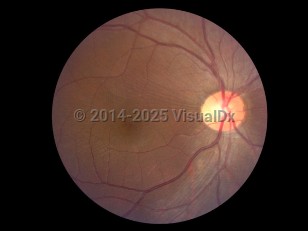Macular pucker - External and Internal Eye
Alerts and Notices
Important News & Links
Synopsis

Macular pucker, or an epiretinal membrane, is contracting scar tissue on the surface of the retina that can lead to a wrinkle, or pucker, in the retina. With age, the vitreous body that accounts for the majority of the volume of the eye begins to decrease in size. Since the vitreous is attached to the retina, this can often create a pulling effect on the surface of the retina. While usually benign, in some cases this action may lead to an inflammatory response at the site of detachment from the retina. As a result, scar tissue can wrinkle or pucker the retina. When this occurs over the macula, the part of the retina responsible for fine detail, central vision can become distorted.
Epiretinal membranes are most commonly idiopathic in response to aging changes in the vitreous, such as a posterior vitreous detachment, but may be secondary to inflammation caused by retinal vascular disease, trauma, or history of intraocular surgery or retinal detachment.
Macular pucker may also be referred to as epiretinal membrane, preretinal membrane, retina wrinkle, surface wrinkle retinopathy, cellophane maculopathy, or premacular fibrosis.
The condition typically occurs in persons over 50 years of age. Patients may describe blurry or mildly distorted vision, in which straight lines may appear curved, as well as binocular double vision. Patients may also struggle with seeing fine detail and reading small print, given the visual distortion. Advanced cases may lead to blind spots in central vision. The vast majority of cases are mild and asymptomatic.
Epiretinal membranes are most commonly idiopathic in response to aging changes in the vitreous, such as a posterior vitreous detachment, but may be secondary to inflammation caused by retinal vascular disease, trauma, or history of intraocular surgery or retinal detachment.
Macular pucker may also be referred to as epiretinal membrane, preretinal membrane, retina wrinkle, surface wrinkle retinopathy, cellophane maculopathy, or premacular fibrosis.
The condition typically occurs in persons over 50 years of age. Patients may describe blurry or mildly distorted vision, in which straight lines may appear curved, as well as binocular double vision. Patients may also struggle with seeing fine detail and reading small print, given the visual distortion. Advanced cases may lead to blind spots in central vision. The vast majority of cases are mild and asymptomatic.
Codes
ICD10CM:
H35.379 – Puckering of macula, unspecified eye
SNOMEDCT:
367649002 – Epiretinal membrane
H35.379 – Puckering of macula, unspecified eye
SNOMEDCT:
367649002 – Epiretinal membrane
Look For
Subscription Required
Diagnostic Pearls
Subscription Required
Differential Diagnosis & Pitfalls

To perform a comparison, select diagnoses from the classic differential
Subscription Required
Best Tests
Subscription Required
Management Pearls
Subscription Required
Therapy
Subscription Required
References
Subscription Required
Last Updated:02/18/2014

